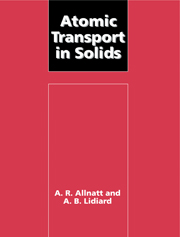Book contents
- Frontmatter
- Contents
- Preface
- List of principal symbols
- 1 Atomic movements in solids – phenomenological equations
- 2 Imperfections in solids
- 3 Statistical thermodynamics of crystals containing point defects
- 4 Non-equilibrium thermodynamics of atomic transport processes in solids
- 5 Some applications of non-equilibrium thermodynamics to solids
- 6 Microscopic theories – the master equation
- 7 Kinetic theory of relaxation processes
- 8 Kinetic theory of isothermal diffusion processes
- 9 The theory of random walks
- 10 Random-walk theories of atomic diffusion
- 11 Transport coefficients of dilute solid solutions – results and applications
- 12 The evaluation of nuclear magnetic relaxation rates
- 13 Theories of concentrated and highly defective systems
- References
- Index
8 - Kinetic theory of isothermal diffusion processes
Published online by Cambridge University Press: 28 December 2009
- Frontmatter
- Contents
- Preface
- List of principal symbols
- 1 Atomic movements in solids – phenomenological equations
- 2 Imperfections in solids
- 3 Statistical thermodynamics of crystals containing point defects
- 4 Non-equilibrium thermodynamics of atomic transport processes in solids
- 5 Some applications of non-equilibrium thermodynamics to solids
- 6 Microscopic theories – the master equation
- 7 Kinetic theory of relaxation processes
- 8 Kinetic theory of isothermal diffusion processes
- 9 The theory of random walks
- 10 Random-walk theories of atomic diffusion
- 11 Transport coefficients of dilute solid solutions – results and applications
- 12 The evaluation of nuclear magnetic relaxation rates
- 13 Theories of concentrated and highly defective systems
- References
- Index
Summary
Introduction
In the previous chapter we showed how the thermally activated movements of defects of low symmetry (e.g. solute–defect pairs) may give rise to dielectric and anelastic relaxation processes. To do so we employed a particular example of the master equation (already introduced in Chapter 6) to represent the movement of these defects among the possible configurations and orientations open to them. These systems were, by assumption, spatially uniform, but it is natural to seek to extend such a theoretical approach to spatially non-uniform systems in which necessarily there will be diffusion processes taking place. Such extensions are the subject of this chapter. We call them kinetic theories because in them we are concerned with the changes in time of the distributions of the solute atoms, defects, solute–defect pairs, etc. in space and among available configurations. We shall use such approaches to find expressions for the diffusion coefficients and the more general transport coefficients of non-equilibrium thermodynamics for dilute alloys and solid solutions. Both interstitial and substitutional solid solutions are considered. In doing so we shall give quantitative expression to the correlation effects anticipated in atomic migration coefficients when defect mechanisms are active (cf. §§2.5.3 and 5.5). The treatments are mostly limited to isothermal systems, although they can be extended to systems in a thermal gradient.
Kinetic theories come in a variety of forms, depending on the characteristics of the systems of interest and on the physical quantities to be represented (e.g. transport coefficients, quasi-elastic scattering functions, Mössbauer cross-sections, etc.). As elsewhere, the aim is to achieve a useful level of generality and this is achieved for systems dilute in both defects and solute atoms.
- Type
- Chapter
- Information
- Atomic Transport in Solids , pp. 270 - 316Publisher: Cambridge University PressPrint publication year: 1993

